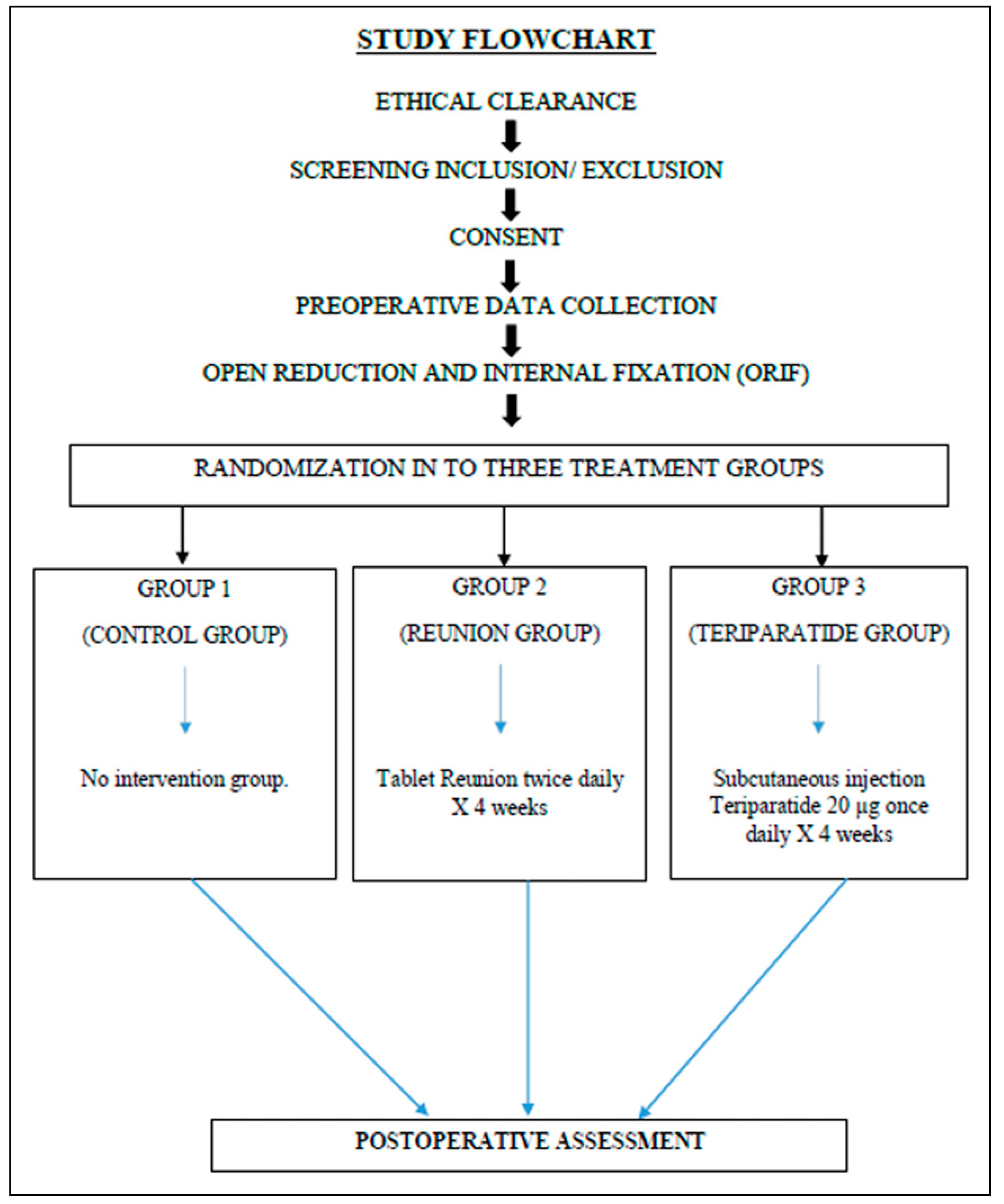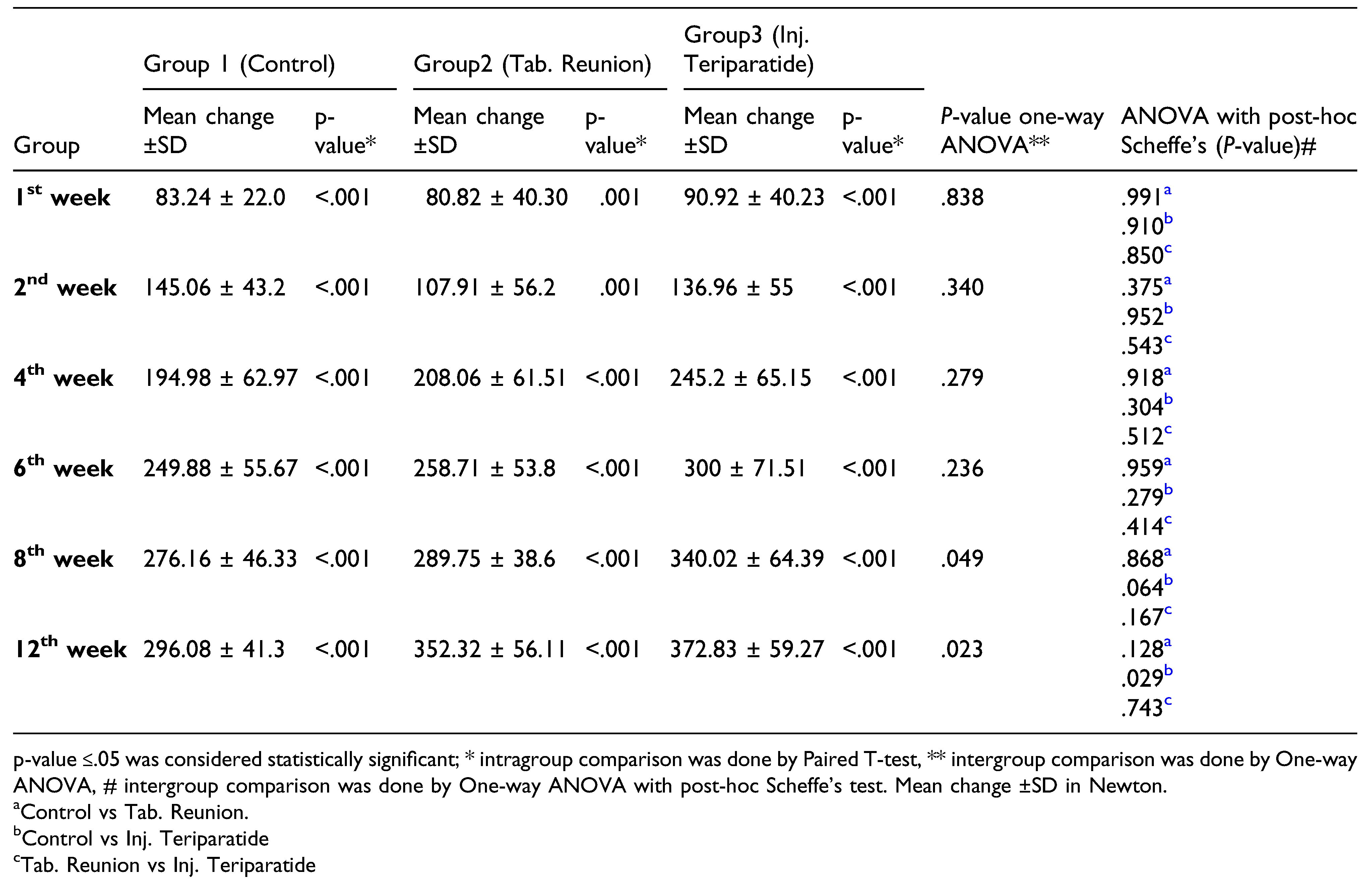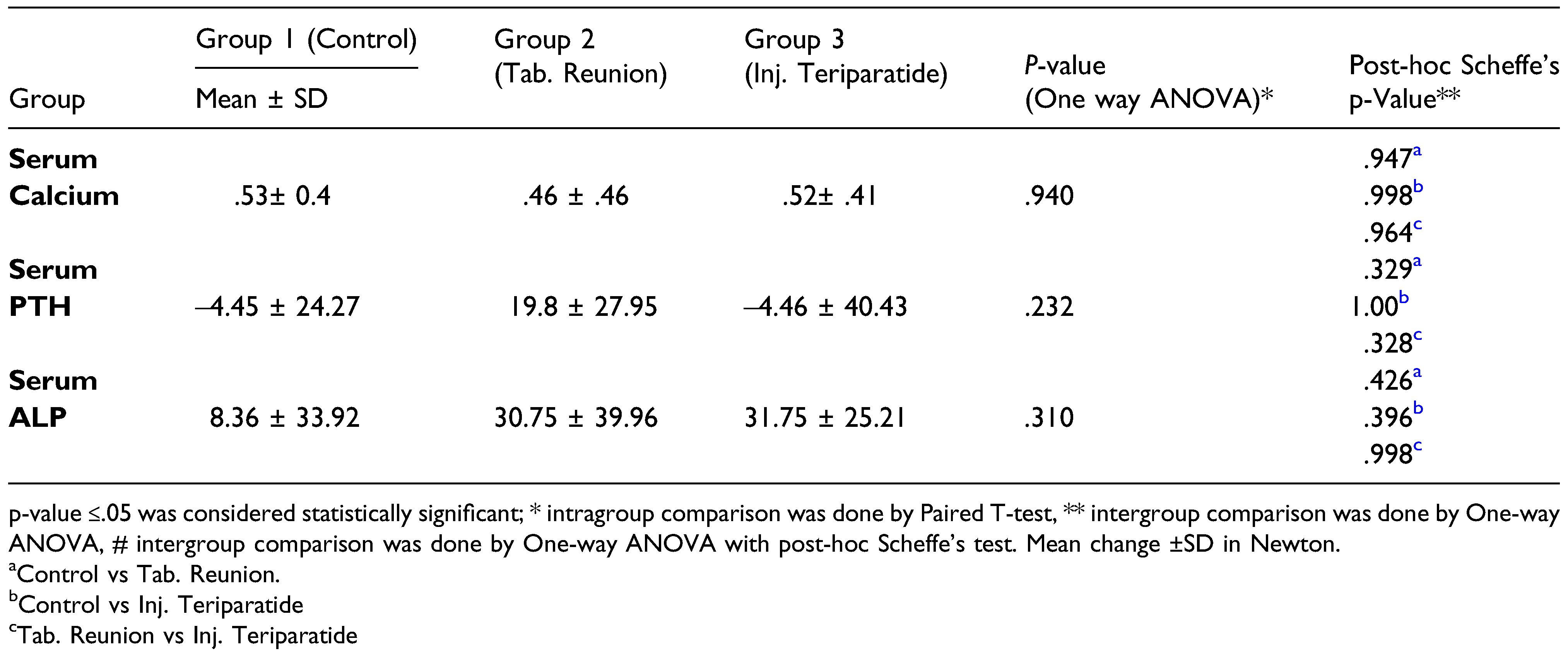Comparison of Teriparatide and Combination of Cissus Quadrangularis and Dalbergia Sissoo on Bone Healing Against the Control Group in Maxillofacial Fractures: A Randomized Open-Label Control Trial
Abstract
Introduction
Materials and Methods
Trial Design
Settings and Consents
Eligibility Criteria
Sample Size Calculation
Randomization, Allocation Concealment, and Blinding
Intervention
Outcome Measures
- The pain was evaluated using a numerical rating scale (NRS) score preoperatively and postoperatively at first week, second week, fourth week, and sixth week.
- Fracture site mobility was evaluated preoperatively and postoperatively at first week, fourth week, and eighth week.
- In our study, we had used Flexi-force sensor for recording bite force which was standardized and calibrated by evaluating 20 healthy individuals. The mean ABF and PBF were recorded —140 N and 350 N, and these values were used for further comparison. ABF and PBF measurement was done in all the patients preoperatively and postoperatively at first week, second week, fourth week, sixth week, eighth week, and 12th week.
- Serum osteogenic markers (Ca, PTH, and ALP) were evaluated preoperatively and postoperatively at the fourth week.
Statistical Analysis
Results
Discussion
Limitations of the Study
Funding
Acknowledgments
Declaration of Conflicting Interests
Appendix
| Abbreviations | |
| ABF | Anterior Bite Force |
| PBF | Posterior Bite force |
| PTH | Parathormone |
| ALP | Alkaline phosphatase |
References
- Kazem Shakouri, S.; Soleimanpour, J.; Salekzamani, Y.; Oskuie, M.R. Effect of low-level laser therapy on the fracture healing process. Laser Med Sci. 2010, 25, 73–77. [Google Scholar] [CrossRef] [PubMed]
- Kyllönen, L.; D’Este, M.; Alini, M.; Eglin, D. Local drug delivery for enhancing fracture healing in osteoporotic bone. Acta Biomater. 2015, 11, 412–434. [Google Scholar] [PubMed]
- Anil, S.; Al-Sulaimani, A.F.; Beeran, A.E.; Chalisserry, E.P.; Varma, H.P.R.; Al Amri, M.D. Drug Delivery Systems in Bone Regeneration and Implant Dentistry [Internet]. In: Turkyilmaz I, ed. Current Concepts in Dental Implantology. InTech; 2015. Available online: http://www.intechopen.com/books/current-concepts-in-dentalimplantology/drug-delivery-systems-in-bone-regenerationand-implant-dentistry. (accessed on 28 December 2020).
- Petrisor, B.; Lisson, S.; Sprague, S. Extracorporeal shockwave therapy: A systematic review of its use in fracture management. Indian J Orthop. 2009, 43, 161. [Google Scholar]
- Pounder, N.M.; Harrison, A.J. Low intensity pulsed ultrasound for fracture healing: A review of the clinical evidence and the associated biological mechanism of action. Ultrasonics. 2008, 48, 330–338. [Google Scholar]
- Della Rocca, G. The science of ultrasound therapy for fracture healing. Indian J Orthop. 2009, 43, 121. [Google Scholar] [CrossRef]
- Brixen, K.T.; Christensen, B.; Ejersted, C.; Langdahl, B.L. Teriparatide (Biosynthetic Human Parathyroid Hormone 1-34): A New Paradigm in the Treatment of Osteoporosis. Pharmacol Toxicol. 2004, 94, 260–270. [Google Scholar]
- Silva, B.C.; Bilezikian, J.P. Parathyroid hormone: anabolic and catabolic actions on the skeleton. Curr Opin Pharmacol. 2015, 22, 41–50. [Google Scholar]
- Chan, K. Some aspects of toxic contaminants in herbal medicines. Chemosphere. 2003, 52, 1361–1371. [Google Scholar]
- Khedgikar, V.; Gautam, J.; Kushwaha, P.; et al. A standardized phytopreparation from an Indian medicinal plant (Dalbergia sissoo) has antiresorptive and bone-forming effects on a postmenopausal osteoporosis model of rat. Menopause. 2012, 19, 1336–1346. [Google Scholar]
- Kushwaha, P.; Khedgikar, V.; Gautam, J.; et al. A novel therapeutic approach with Caviunin-based isoavonoid that en routes bone marrow cells to bone formation via BMP2/Wntb-catenin signaling. Cell Death Dis 16.
- Migliaccio, S.; Brama, M.; Spera, G. The differential effects of bisphosphonates, SERMS (selective estrogen receptor modulators), and parathyroid hormone on bone remodeling in osteoporosis. Clin Interv Aging. 2007, 2, 55–64. [Google Scholar] [PubMed]
- Hajare, S.W.; Suresh, C.; Tandan, S.K.; Sarma, J.; Lal, J.; Telang, A.G. Analgesic and antipyretic activities of Dalbergia sissoo leaves. Indian J Pharmacol [Internet]. 2000, 32, 357–360. Available online: https://www.ijp-online.com/article.asp?issn=0253-7613 (accessed on 29 December 2020).
- Panthong, A.; Supraditaporn, W.; Kanjanapothi, D.; Taesotikul, T.; Reutrakul, V. Analgesic, anti-inflammatory and venotonic effects of Cissus quadrangularis Linn. J Ethnopharmacol. 2007, 110, 264–270. [Google Scholar] [PubMed]
- Mishra, G.; Srivastava, S.; Nagori, B.P. Pharmacological and Therapeutic Activity of Cissus Quadrangularis: An Overview 13.
- Waalen, J. Current and emerging therapies for the treatment of osteoporosis. J Exp Pharmacol. 2010, 121. [Google Scholar]
- Chen, C.M.; Lin, P.Y.; Chen, Y.C.; et al. Effects of teriparatide on lung function and pain relief in women with multiple osteoporotic vertebral compression fractures. Surg Neurol Int. 2014, 5 (Suppl. 7), S339–S342. [Google Scholar] [PubMed]
- Kasukawa, Y.; Miyakoshi, N.; Ebina, T.; et al. Enhanced bone healing and decreased pain in sacral insufficiency fractures after teriparatide treatment: retrospective clinical-based observational study. Clinical Cases in Mineral and Bone Metabolism. 2017, 14, 140. [Google Scholar]
- Johansson, T. PTH 1-34 (teriparatide) may not improve healing in proximal humerus fractures. Acta Orthop. 2016, 87, 79–82. [Google Scholar]
- Aspenberg, P.; Genant, H.K.; Johansson, T.; et al. Teriparatide for acceleration of fracture repair in humans: A prospective, randomized, double-blind study of 102 postmenopausal women with distal radial fractures. J Bone Miner Res. 2010, 25, 404–414. [Google Scholar]
- Vivek, G.K.; Shetty, A.; Vaibhav, N.; Imran, M. A comparative study of single 3-D titanium plate versus conventional Champy’s 2 miniplate fixation in the management of mandibular anterior fracture: A prospective clinical study. Journal of Advanced Clinical & Research Insights. 2016, 3, 194–199. [Google Scholar]
- Al-Moraissi, E.A.; Mounair, R.M.; El-Sharkawy, T.M.; El-Ghareeb, T.I. Comparison between three-dimensional and standard miniplates in the management of mandibular angle fractures: a prospective, randomized, double-blind, controlled clinical study. Int J Oral Maxillofac Surg. 2015, 44, 316–321. [Google Scholar] [PubMed]
- Sehgal, S.; Ramanujam, L.; Prasad, K.; Krishnappa, R. Threedimensional v/s standard titanium miniplate fixation in the management of mandibular fractures A randomized clinical study. J Cranio-Maxillofacial Surg. 2014, 42, 1292–1299. [Google Scholar]
- Mohammad, S.; Pal, U.; Pradhan, R.; Singh, N. Herbal remedies for mandibular fracture healing. Natl J Maxillofac Surg. 2014, 5, 35. [Google Scholar] [PubMed]
- Singh, N.; Singh, V.; Singh, R.; Pant, A.; Pal, U.; Malkunje, L.; et al. Osteogenic potential of cissus qudrangularis assessed with osteopontin expression. Natl J Maxillofac Surg. 2013, 4, 52. [Google Scholar]
- Satterwhite, J.; Heathman, M.; Miller, P.D.; Mar´ın, F.; Glass, E.V.; Dobnig, H. Pharmacokinetics of Teriparatide (rhPTH[1-34]) and Calcium Pharmacodynamics in Postmenopausal Women with Osteoporosis. Calcif Tissue Int. 2010, 87, 485–492. [Google Scholar]
- Singh, V.; Pal, U.; Mohammad, S.; Singh, N.; Dhasmana, S.; Singh, N. Clinical evaluation of cissus quadrangularis and moringa oleifera and osteoseal as osteogenic agents in mandibular fracture. Natl J Maxillofac Surg. 2011, 2, 132. [Google Scholar] [PubMed]
- Rasale, P.L.; Raut, S.Y.; Narkhede, H.P.; Muddeshwar, M.G. Biochemical and hormonal evaluation of Cissus quadrangularis in accelerating healing process of bone fracture: A clinical study. Int J Res Ayurveda Pharm. 2014, 5, 461–469. [Google Scholar]
- Thouverey, C.; Caverzasio, J. Suppression of p38α MAPK Signaling in Osteoblast Lineage Cells Impairs Bone Anabolic Action of Parathyroid Hormone. J Bone Miner Res. 2016, 31, 985–993. [Google Scholar]
- Khan, M.; Jose, A.; Sharma, S. Physiology, Parathyroid Hormone. [Internet]. StatPearls , Treasure Island (FL). StatPearls Publishing; 2020. Available online: http://www.ncbi.nlm.nih.gov/books/NBK499940/ (accessed on 29 December 2020).
- Ban, Z.-N.; Li, Z.-J.; Gu, Q.-S.; Cheng, J.; Huang, Q.; Xing, S.-X. Correlation of serum PTH level and fracture healing speed in elderly patients with hip fracture. J Orthop Surg Res. 2019, 14, 361. [Google Scholar]
- Anastasilakis, A.D.; Polyzos, S.A.; Goulis, D.G.; Slavakis, A.; Efstathiadou, Z.; Kita, M.; et al. Endogenous intact PTH is suppressed during Teriparatide (rhPTH 1-34) administration in postmenopausal women with established osteoporosis. Endocr J. 2008, 55, 613–616. [Google Scholar]
- Javinani, A.; Aghaei Meybodi, H.R.; Kavosi, H. Extremely elevated serum alkaline phosphatase level upon treatment with teriparatide: a case report. J Med Case Rep. 2020, 14, 87. [Google Scholar] [PubMed]
- Amol, D. Safety and Efficacy of a Standardized Extract from Leaves of Dalbergia sissoo in Healing of Long Bone Fracture: A Pilot Clinical Study. J Complement Med Altern Healthc [Internet]. 2018, 5. Available online: https://juniperpublishers.com/jcmah/JCMAH.MS.ID.555654.php (accessed on 22 December 2020).
- Brahmkshatriya, H.R.; Shah, K.A.; Ananthkumar, G.B.; Brahmkshatriya, M.H. Clinical evaluation of Cissus quadrangularis as osteogenic agent in maxillofacial fracture: A pilot study. Ayu. 2015, 36, 169–173. [Google Scholar]
- Kim, S.-M.; Kang, K.-C.; Kim, J.W.; Lim, S.-J.; Hahn, M.H. Current Role and Application of Teriparatide in Fracture Healing of Osteoporotic Patients: A Systematic Review. Journal of Bone Metabolism. 2017, 24, 65. [Google Scholar] [PubMed]



 |
 |
 |
 |
 |
© 2022 by the author. The Author(s) 2022.
Share and Cite
PG, G.; Chugh, A.; Chaudhry, K.; Kaur, A.; Kumar, P.; Gaur, S.; Kumar, S.; Singh, S. Comparison of Teriparatide and Combination of Cissus Quadrangularis and Dalbergia Sissoo on Bone Healing Against the Control Group in Maxillofacial Fractures: A Randomized Open-Label Control Trial. Craniomaxillofac. Trauma Reconstr. 2023, 16, 23-33. https://doi.org/10.1177/19433875211067007
PG G, Chugh A, Chaudhry K, Kaur A, Kumar P, Gaur S, Kumar S, Singh S. Comparison of Teriparatide and Combination of Cissus Quadrangularis and Dalbergia Sissoo on Bone Healing Against the Control Group in Maxillofacial Fractures: A Randomized Open-Label Control Trial. Craniomaxillofacial Trauma & Reconstruction. 2023; 16(1):23-33. https://doi.org/10.1177/19433875211067007
Chicago/Turabian StylePG, Gigi, Ankita Chugh, Kirti Chaudhry, Amanjot Kaur, Pravin Kumar, Shubham Gaur, Shailendra Kumar, and Surjit Singh. 2023. "Comparison of Teriparatide and Combination of Cissus Quadrangularis and Dalbergia Sissoo on Bone Healing Against the Control Group in Maxillofacial Fractures: A Randomized Open-Label Control Trial" Craniomaxillofacial Trauma & Reconstruction 16, no. 1: 23-33. https://doi.org/10.1177/19433875211067007
APA StylePG, G., Chugh, A., Chaudhry, K., Kaur, A., Kumar, P., Gaur, S., Kumar, S., & Singh, S. (2023). Comparison of Teriparatide and Combination of Cissus Quadrangularis and Dalbergia Sissoo on Bone Healing Against the Control Group in Maxillofacial Fractures: A Randomized Open-Label Control Trial. Craniomaxillofacial Trauma & Reconstruction, 16(1), 23-33. https://doi.org/10.1177/19433875211067007



